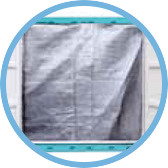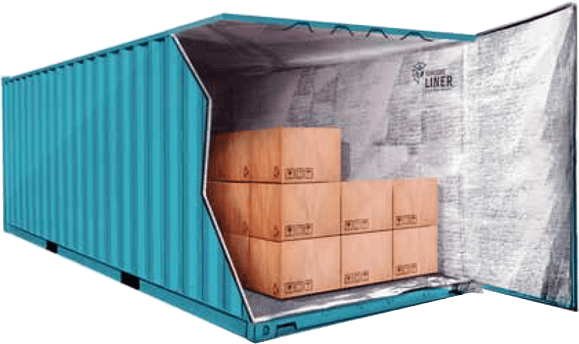
TEMCORE LINER
The Temcore Liner uses the latest in thermal insulation technology to create a fully sealed environment and prevent temperature fluctuations.
THERMAL LINERS
With five layers of fully reflective aluminum, the Temcore Liner provides the extreme temperature protection of a typical thermal liner while also protecting against condensation and shipping container contaminants.

Convenient Click-On-Top Hanging System

Total Reflectivity and Insulation

Highly Protective Five Layer Design

Fully Sealed Environment
Temcore Liners
Temcore Liner stabilizes shipping container temperatures using the latest in reflective and thermal insulation technology, keeping your cargo safe from port to port and beyond.

The Temcore Liner ensures your cargo makes it to its destination unharmed by maintaining stable temperatures the whole way. Want to learn more?
FREQUENTLY ASKED QUESTIONS
What is Temcore Liner?
Temcore thermal liner is a six-sided liner designed to cover the interior of a shipping container and protect the goods stored within. Some prefer a 5-sided liner where the floor is removed. I can also be known as a cargo quilt, a thermal container liner shields products from the extreme temperature fluctuations that occur during lengthy sea and land journeys.
Thanks to the Temcore thermal containing liner’s reflective and thermal insulation technology, the interior air of the container remains stable, keeping your cargo safe and secure throughout transit.
How does Temcore Liner work?
Thermal liners are designed to provide protection from extreme temperatures. As shipping containers make their way through different climates, exterior temperatures can fluctuate dramatically. Without a thermal liner, the external climate can influence the internal temperature of a container and cause product damage or spoilage; with a liner, the interior temperature remains stable.
Cargo quilts also keep goods dry during shipping. As temperatures change, moisture can accumulate on the walls and ceiling of containers and drip onto your products. When moisture-sensitive cargo is left unprotected, it can be irrevocably damaged and affect your bottom line. A liner negates the effects of fluctuating external temperatures, so your container stays moisture-free.
The Temcore Liner is designed to insulate and protect against all of these issues—cargo sweat, container rain, and radiant heat—ensuring your product retains its quality throughout the voyage.
What kind of thermal insulation materials is Temcore Liner made from?
Temcore Liner uses an advanced thermal lining fabric crafted from individual layers of fully reflective aluminum. Because of aluminum’s low emissivity value, your cargo is completely protected from radiant heat transfer. Aluminum is one of the least emissive materials on the market, making it an ideal choice for thermal liners.
The thermal lining material creates an insulative barrier between the shipping container and the goods within, so external temperature changes don’t affect the internal temperature.
What are the benefits of a thermal liner?
Temcore’s advanced thermal lining material can protect your cargo from a variety of shipping inevitabilities, including:
- Excessive heat – Whether at sea or on land, shipping containers are routinely subject to direct sunlight and elevated ambient temperatures—sometimes reaching as high as 135 degrees Fahrenheit (57.2 degrees Celsius). Without a protective liner, a container’s metal walls and ceilings conduct this heat, transferring it to the goods inside.
- Container rain – Although containers are frequently exposed to extreme heat, they can also travel through cold weather. When the external temperature drops below the container’s internal temperature, the moisture in the air can condense on the ceiling and walls of the container. These phenomena—known respectively as container rain and container sweat—can cause severe moisture damage over days or months.
- Contamination – Goods in a bare shipping container are at a greater risk of contamination, especially if the container was not cleaned thoroughly before loading.
All of these issues can irreversibly damage the goods inside a shipping container. A cargo quilt significantly reduces the possibility of problems that can lead to product losses. As such, thermal container liners are beneficial for your bottom line.
Thermal liners are also an eco-conscious choice. While refrigerated shipping containers require constant power to maintain the desired internal temperature, cargo quilts are a passive form of temperature regulation. Additionally, when proper care is taken, thermal container liners are reusable.
How do you install a thermal liner in a shipping container?
A thermal container liner is meant to cover the interior of a shipping container completely. To install the liner, you prepare by taking the straps provided and thread them through the container hooks until you have created a taut line which will be used to hook the liner on the top and bottom. You place the liner in the middle of the container and unfold it. The Temcore Liner comes equipped with a click-on-top and bottom hanging system. Once the liner is in place, a set of durable hooks can clip onto the top of the shipping container to keep the material secure.
Note that containers should be clean, dry, and dust-free before liner installation.
What’s the difference between a thermal liner and a thermal blanket?
Thermal liners and thermal blankets rely on the same reflective and insulative technology to keep shipped goods at an optimal temperature. However, there are some notable differences between the two.
First, thermal container liners cover every inch of a shipping container’s roof, floor, and walls. Thermal blankets are smaller, covering only a handful of boxes, crates, or pallets in a shipment.
Furthermore, thermal blankets only provide five-sided protection; the bottom of the pallet or crate is left uncovered. Thermal liners, on the other hand, offer 360° coverage.
Thermal blankets can be more cost-effective when only a portion of the goods inside a shipping container needs a temperature-controlled environment. However, if the entire container needs to stay within a particular temperature range, a thermal liner may be the more logical choice.
What type of goods should be transported in a lined container?
Any product that needs to stay clean, dry, and cool should ideally be shipped in a container equipped with a cargo quilt. Some of the most common goods transported in lined containers include:
- Food
- Beverages
- Medications
- Vaccines
- Paint
- Chemicals
- Electronics
- Equipment
- Auto Parts
- Can and Bottle
- Furniture
- High End Goods
- Nuts and Seeds needing to stay fresh
While liners protect the goods inside a container from external contaminants, they can also keep the inside of the container safe from leaks and spills. As such, if you’re transporting hazardous liquids, you may want to use a liner to avoid damaging the container or necessitating a cleanup.





